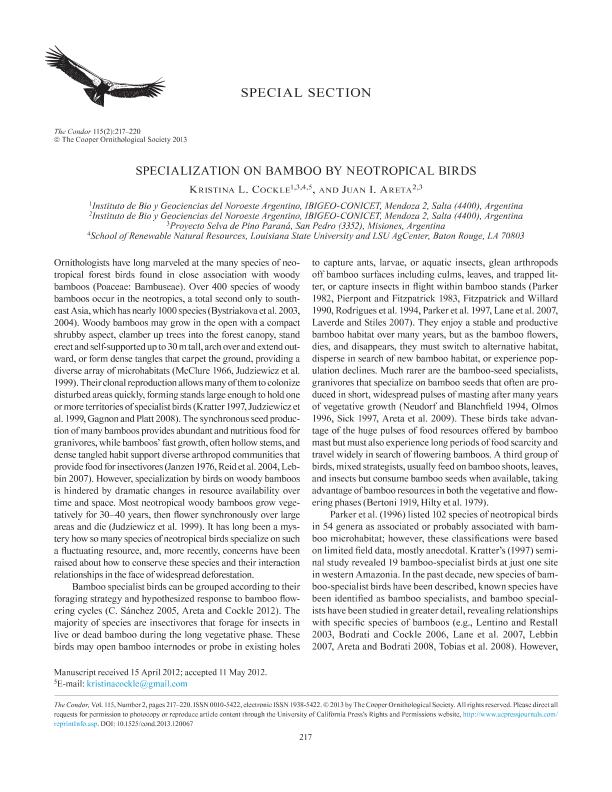Mostrar el registro sencillo del ítem
dc.contributor.author
Cockle, Kristina Louise

dc.contributor.author
Areta, Juan Ignacio

dc.date.available
2015-11-02T13:38:25Z
dc.date.issued
2013-05
dc.identifier.citation
Cockle, Kristina Louise; Areta, Juan Ignacio; Specialization on bamboo by Neotropical birds; Cooper Ornithological Society; The Condor; 115; 2; 5-2013; 217-220
dc.identifier.issn
0010-5422
dc.identifier.uri
http://hdl.handle.net/11336/2605
dc.description.abstract
Ornithologists have long marveled at the many species of neotropical forest birds found in close association with woody bamboos (Poaceae: Bambuseae). Over 400 species of woody bamboos occur in the neotropics, a total second only to southeast Asia, which has nearly 1000 species (Bystriakova et al. 2003, 2004). Woody bamboos may grow in the open with a compact shrubby aspect, clamber up trees into the forest canopy, stand erect and self-supported up to 30 m tall, arch over and extend outward, or form dense tangles that carpet the ground, providing a diverse array of microhabitats (McClure 1966, Judziewicz et al. 1999). Their clonal reproduction allows many of them to colonize disturbed areas quickly, forming stands large enough to hold one or more territories of specialist birds (Kratter 1997, Judziewicz et al. 1999, Gagnon and Platt 2008). The synchronous seed production of many bamboos provides abundant and nutritious food for granivores, while bamboos’ fast growth, often hollow stems, and dense tangled habit support diverse arthropod communities that provide food for insectivores (Janzen 1976, Reid et al. 2004, Lebbin 2007). However, specialization by birds on woody bamboos is hindered by dramatic changes in resource availability over time and space. Most neotropical woody bamboos grow vegetatively for 30–40 years, then flower synchronously over large areas and die (Judziewicz et al. 1999). It has long been a mystery how so many species of neotropical birds specialize on such a fluctuating resource, and, more recently, concerns have been raised about how to conserve these species and their interaction relationships in the face of widespread deforestation.
dc.format
application/pdf
dc.language.iso
eng
dc.publisher
Cooper Ornithological Society
dc.rights
info:eu-repo/semantics/openAccess
dc.rights.uri
https://creativecommons.org/licenses/by-nc-sa/2.5/ar/
dc.subject
Chusquea
dc.subject
Guadua
dc.subject
Merostachys
dc.subject
Oxytenanthera Abyssinica
dc.subject.classification
Zoología, Ornitología, Entomología, Etología

dc.subject.classification
Ciencias Biológicas

dc.subject.classification
CIENCIAS NATURALES Y EXACTAS

dc.title
Specialization on bamboo by Neotropical birds
dc.type
info:eu-repo/semantics/article
dc.type
info:ar-repo/semantics/artículo
dc.type
info:eu-repo/semantics/publishedVersion
dc.date.updated
2016-03-30 10:35:44.97925-03
dc.identifier.eissn
1938-5129
dc.journal.volume
115
dc.journal.number
2
dc.journal.pagination
217-220
dc.journal.pais
Estados Unidos

dc.journal.ciudad
Washington, D.C.
dc.description.fil
Fil: Cockle, Kristina Louise. Consejo Nacional de Investigaciones Científicas y Técnicas. Centro Científico Tecnológico Salta. Instituto de Bio y Geociencias del Noroeste Argentino; Argentina. Universidad del Estado de Luisiana. Facultad de Recursos Naturales Renovables; Estados Unidos
dc.description.fil
Fil: Areta, Juan Ignacio. Consejo Nacional de Investigaciones Científicas y Técnicas. Centro Científico Tecnológico Salta. Instituto de Bio y Geociencias del Noroeste Argentino; Argentina
dc.journal.title
The Condor

dc.relation.alternativeid
info:eu-repo/semantics/altIdentifier/url/http://www.bioone.org/doi/abs/10.1525/cond.2013.120067
dc.relation.alternativeid
info:eu-repo/semantics/altIdentifier/doi/http://dx.doi.org/10.1525/cond.2013.120067
Archivos asociados
